Journal Description
Oral — Health, Diseases, Therapies, and Technologies
Oral
— Health, Diseases, Therapies, and Technologies is an international, peer-reviewed, open access journal on oral health published quarterly online by MDPI.
- Open Access— free for readers, with article processing charges (APC) paid by authors or their institutions.
- High Visibility: indexed within ESCI (Web of Science), Scopus and other databasaes.
- Rapid Publication: manuscripts are peer-reviewed and a first decision is provided to authors approximately 23.3 days after submission; acceptance to publication is undertaken in 9.9 days (median values for papers published in this journal in the first half of 2025).
- Recognition of Reviewers: APC discount vouchers, optional signed peer review, and reviewer names published annually in the journal.
Impact Factor:
1.1 (2024);
5-Year Impact Factor:
1.0 (2024)
Latest Articles
Artificial Intelligence Tools for Dental Caries Detection: A Scoping Review
Oral 2025, 5(4), 102; https://doi.org/10.3390/oral5040102 - 12 Dec 2025
Abstract
Background/Objectives: Despite decades of technological progress, the diagnosis of dental caries still depends largely on subjective, operator-dependent assessment, leading to inconsistent detection of early lesions and delayed intervention. Artificial intelligence (AI) has emerged as a transformative approach capable of standardizing diagnostic performance and,
[...] Read more.
Background/Objectives: Despite decades of technological progress, the diagnosis of dental caries still depends largely on subjective, operator-dependent assessment, leading to inconsistent detection of early lesions and delayed intervention. Artificial intelligence (AI) has emerged as a transformative approach capable of standardizing diagnostic performance and, in some cases, surpassing human accuracy. This scoping review critically synthesizes the current evidence on AI for caries detection and examines its true translational readiness for clinical practice. Methods: A comprehensive literature search was conducted in PubMed, Scopus, and Web of Science (WoS), covering studies published from January 2019 to June 2024, in accordance with PRISMA-ScR guidelines. Eligible studies included original research evaluating the use of AI for dental caries detection, published in English or Spanish. Review articles, editorials, opinion papers, and studies unrelated to caries detection were excluded. Two reviewers independently screened, extracted, and charted data on imaging modality, sample characteristics, AI architecture, validation approach, and diagnostic performance metrics. Extracted data were summarized narratively and comparatively across studies using tabulated and graphical formats. Results: Thirty studies were included from an initial pool of 617 records. Most studies employed convolutional neural network (CNN)-based architectures and reported strong diagnostic performance, although these results come mainly from experimental settings and should be interpreted with caution. Bitewing radiography dominated the evidence base, reflecting technological maturity and greater reproducibility compared with other imaging modalities. Conclusions: Although the reported metrics are technically robust, the current evidence remains insufficient for real-world clinical adoption. Most models were trained on small, single-source datasets that do not reflect clinical diversity, and only a few underwent external or multicenter validation. Until these translational and methodological gaps are addressed, AI for caries detection should be regarded as promising yet not fully clinically reliable. By outlining these gaps and emerging opportunities, this review offers readers a concise overview of the current landscape and the key steps needed to advance AI toward meaningful clinical implementation.
Full article
(This article belongs to the Special Issue Artificial Intelligence in Oral Medicine: Advancements and Challenges)
►
Show Figures
Open AccessReview
Impact of Oral and Gut Microbiota Dysbiosis in Patients with Multiple Myeloma and Hematological Malignancies: A Narrative Review
by
Antonio Belmonte, Ylenia Leanza, Alessandro Polizzi, Alessandra Romano, Alessandro Allegra, Rosalia Leonardi, Cristina Panuzzo and Gaetano Isola
Oral 2025, 5(4), 101; https://doi.org/10.3390/oral5040101 - 11 Dec 2025
Abstract
►▼
Show Figures
The interplay between the oral and gut microbiota and systemic health has garnered significant attention in recent years, particularly concerning hematological malignancies. Multiple myeloma and other hematological cancers are characterized by immune dysfunction, creating a bidirectional relationship with microbial communities. Dysbiosis, defined as
[...] Read more.
The interplay between the oral and gut microbiota and systemic health has garnered significant attention in recent years, particularly concerning hematological malignancies. Multiple myeloma and other hematological cancers are characterized by immune dysfunction, creating a bidirectional relationship with microbial communities. Dysbiosis, defined as an imbalance in microbial composition, may influence disease progression, treatment response, and overall prognosis. This narrative review is based on a non-systematic search of PubMed and Scopus (2010–2024) using terms related to oral microbiota, gut microbiota, dysbiosis, hematological malignancies, multiple myeloma, immune modulation, and treatment-related complications. Studies were selected for relevance to pathogenesis, immune regulation, clinical implications, and therapeutic interactions. As this is a narrative review, no quantitative synthesis or formal grading of evidence strength was performed; findings are therefore interpreted qualitatively based on the available literature. The role of microbial-derived metabolites, their effects on immune modulation, and their potential as biomarkers for disease and treatment outcomes have been explored. Specific attention is given to the implications of dysbiosis in chemotherapy-induced complications, such as mucositis and infections, and emerging therapeutic strategies, including probiotics, prebiotics, and fecal microbiota transplantation. Additionally, the influence of anticancer therapies on microbial ecosystems has been highlighted and the bidirectional impact of host–microbe interactions in shaping disease trajectory has been discussed. Understanding these complex interactions could lead to novel diagnostic and therapeutic approaches, ultimately improving patient outcomes. This review aims to provide clinicians and researchers with a comprehensive overview of current knowledge and future perspectives on the role of oral and gut microbiota in the context of hematological malignancies.
Full article
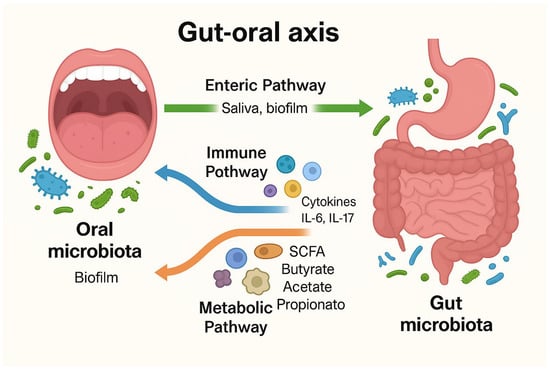
Figure 1
Open AccessArticle
Immediate Effects of Biomimetic Hydroxyapatite Toothpaste and Mouthwash on Dentin Hypersensitivity: A Randomized Controlled Trial
by
Andrea Scribante, Matteo Pellegrini, Alessandro Chiesa, Stefania Crea and Andrea Butera
Oral 2025, 5(4), 100; https://doi.org/10.3390/oral5040100 - 10 Dec 2025
Abstract
Background/Objectives: Dentin hypersensitivity (DH) is associated with gingival recession and dentin exposure. Biomimetic hydroxyapatite (HAp) reduces DH by occluding dentinal tubules, with conventional toothpaste formulations showing benefits. High-density HAp mouthwashes may enhance bioavailability, but comparative evidence is scarce. This trial assessed the immediate
[...] Read more.
Background/Objectives: Dentin hypersensitivity (DH) is associated with gingival recession and dentin exposure. Biomimetic hydroxyapatite (HAp) reduces DH by occluding dentinal tubules, with conventional toothpaste formulations showing benefits. High-density HAp mouthwashes may enhance bioavailability, but comparative evidence is scarce. This trial assessed the immediate desensitizing efficacy of a conventional HAp toothpaste and a high-density HAp mouthwash after professional oral hygiene. Methods: One hundred participants were randomized 1:1 to Biorepair® (Coswell S.p.A., Funo, BO, Italy) Total Protection Toothpaste (Control) or Biorepair® (Coswell S.p.A., Funo, BO, Italy) High-Density Mouthwash (Test). Assessments were performed at baseline (T0), post-debridement (T1), and after product use (T2). The primary endpoint was patient-level Schiff Air Index (SAI). Secondary endpoints included tooth-level SAI, Visual Analog Scale (VAS) scores, and gingival recession (GR). The trial was registered at ClinicalTrials.gov (NCT07057141) and followed CONSORT 2025 guidelines. Friedman and Dunn’s tests and regression models were applied. Results: Both groups showed significant reductions in hypersensitivity. Patient-level mean SAI decreased from 1.47 to 0.66 in the Control and from 1.48 to 0.45 in the Test group, while VAS declined from 3.66 to 1.57 (Control) and from 4.15 to 1.37 (Test). Post hoc analyses showed significant intragroup reductions between T0/T1 and T2 in both groups, with no significant differences between groups at any timepoint. GR remained stable across the study. Regression analyses identified follow-up time and GR as significant predictors, whereas treatment allocation was not, indicating that the acute advantage of the mouthwash at T2 did not persist once longitudinal trends were considered. Conclusions: Both HAp formulations effectively reduced dentin hypersensitivity 30 s after application. The high-density mouthwash exhibited slightly lower mean values at T2, although these differences were not statistically significant.
Full article
(This article belongs to the Collection Synthesis, Testing and Mechanical Behavior of Dental Biomaterials at Different Clinical Parameters)
►▼
Show Figures
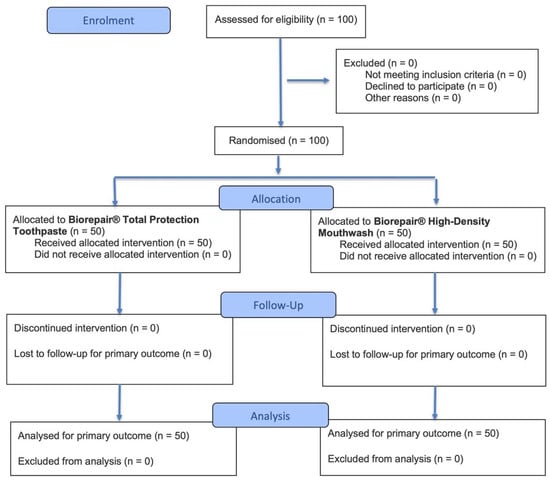
Figure 1
Open AccessArticle
Analysis of Maxillary Anterior Tooth Dimensions and Proportions in Young Cambodians: A Cross-Sectional Study
by
Aliza Tithphit, Benedikt Schneider, Ahmed Othman, Veasna Phit, Hong Yoeu Tith and Constantin von See
Oral 2025, 5(4), 99; https://doi.org/10.3390/oral5040099 - 3 Dec 2025
Abstract
►▼
Show Figures
Background/Purpose: The study aimed to analyze the dimensions and width-to-length ratios of the maxillary anterior teeth in young native Cambodian adults and to assess their relationship with the golden proportion, symmetry, and sexual dimorphism. Materials and Methods: Maxillary study casts of
[...] Read more.
Background/Purpose: The study aimed to analyze the dimensions and width-to-length ratios of the maxillary anterior teeth in young native Cambodian adults and to assess their relationship with the golden proportion, symmetry, and sexual dimorphism. Materials and Methods: Maxillary study casts of 193 eligible Cambodian subjects, aged 18 to 25 years, were retrospectively evaluated. The width and length of their maxillary anterior teeth were measured using a digital caliper. Descriptive statistics, independent-samples t-test at 95% confidence intervals, Kolmogorov-Smirnov, Shapiro-Wilk, and Kruskal-Wallis tests were performed to analyze the data. Results: There was a high level of similarity between first and second quadrant measurements. Females showed slightly higher standard deviations for central incisors and lateral incisors than males across most ratios, indicating more variability in the width-in-length ratios for females. Males exhibited significantly greater tooth dimensions than females. The following results showed statistical significance with p < 0.05 and 95% confidence intervals. The mean crown width of the central incisors was 8.16 mm in males (CI: 8.03–8.29) and 7.87 mm in females (CI: 7.78–7.96). For the lateral incisors, the mean crown width was 6.69 mm in males (CI: 6.53–6.85) and 7.64 mm in females (CI: 7.43–7.85). The width-to-length ratio of the central incisors was higher in females (mean = 0.88; CI: 0.86–0.91) compared with males (mean = 0.87; CI: 0.84–0.89). Overall, proportional relationships remained consistent across genders. The golden proportion guideline was not applicable, as observed ratios ranged from 0.90 to 1.67 (all below 1.618), and RED values exceeded 80%. The null hypothesis was rejected due to the significant gender differences found in tooth dimensions and width-to-length ratios. Conclusions: There was no significant difference in maxillary anterior tooth dimensions for the right and left sides among the Cambodian population. Males had statistically larger teeth than females. Width-to-length ratios were greater in females for central incisors; however, the proportional relationships between the genders remained relatively consistent. The golden proportion and RED proportions did not exist within this population. A smaller size characterizes Cambodian dentition compared to that of other ethnic groups. Finally, these results can serve as an indicator for planning customized esthetic treatment in Cambodians. Future studies with larger sample sizes are needed to ensure the representation of the whole Cambodian population.
Full article
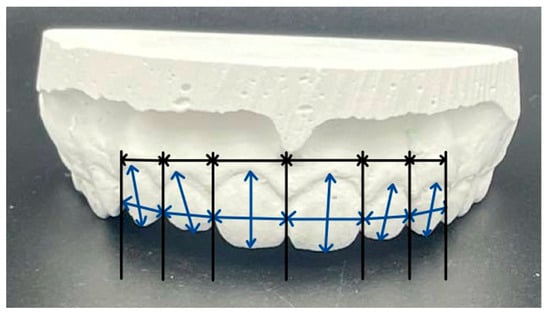
Figure 1
Open AccessArticle
PRF Membranes Enhance Postoperative Recovery After Periapical Surgery: A Single-Blind Randomized Pilot Trial Using 3D Imaging
by
Martin Major, Melinda Polyák, Tamás Würsching, Gábor Kammerhofer, Éva Kocsis, Zsolt Németh and György Szabó
Oral 2025, 5(4), 98; https://doi.org/10.3390/oral5040098 - 3 Dec 2025
Abstract
►▼
Show Figures
Background: Periapical surgery is indicated for persistent periapical lesions that do not respond to conventional endodontic therapy, yet postoperative recovery is often hindered by pain, swelling, and delayed healing. Platelet-rich fibrin (PRF) membranes are autologous biomaterials with regenerative potential, capable of modulating inflammation
[...] Read more.
Background: Periapical surgery is indicated for persistent periapical lesions that do not respond to conventional endodontic therapy, yet postoperative recovery is often hindered by pain, swelling, and delayed healing. Platelet-rich fibrin (PRF) membranes are autologous biomaterials with regenerative potential, capable of modulating inflammation and promoting tissue repair. Methods: This preliminary randomized controlled trial evaluated the effectiveness of PRF membranes in improving postoperative outcomes—specifically pain, swelling, and quality of life—after apicoectomy. Twenty patients requiring periapical surgery were randomly allocated to a PRF group (n = 10) or a control group (n = 10). In the PRF group, autologous PRF membranes were applied over the resected root-end and into the osteotomy cavity before flap closure. In the control group, no PRF membranes or any additional biomaterial were applied, apart from the standard root-end filling material (MTA), which was identically used in both groups as part of the routine apicoectomy protocol. All patients were blinded to allocation, and outcomes were assessed by an independent blinded evaluator. Facial swelling was quantified by 3D facial scanning, pain was recorded daily using a visual analog scale (VAS), and quality of life was evaluated with the PROMIS-29+2 Profile. Results: The PRF group showed significantly reduced swelling (mean volume difference, 7.12 cm3; p = 0.025), lower pain scores (VAS: 1.80 ± 1.22 vs. 3.80 ± 2.44; p = 0.034), and improved quality-of-life domains, including higher Physical Function (p = 0.032) and lower Sleep Disturbance (p = 0.008) scores. Conclusions: Within the limitations of this pilot study, PRF membranes enhanced postoperative recovery after periapical surgery by reducing swelling and pain while improving patient-reported outcomes. Larger multicenter trials are needed to confirm these preliminary findings.
Full article

Figure 1
Open AccessArticle
In Vivo Accuracy Assessment of Two Intraoral Scanners Using Open-Source Software: A Comparative Full-Arch Pilot Study
by
Francesco Puleio, Fabio Salmeri, Ettore Lupi, Ines Urbano, Roberta Gasparro, Simone De Vita and Roberto Lo Giudice
Oral 2025, 5(4), 97; https://doi.org/10.3390/oral5040097 - 2 Dec 2025
Abstract
►▼
Show Figures
Background: The precision of intraoral scanners (IOSs) is a key factor in ensuring the reliability of digital impressions, particularly in full-arch workflows. Although proprietary metrology tools are generally employed for scanner validation, open-source platforms could provide a cost-effective alternative for clinical research. Methods:
[...] Read more.
Background: The precision of intraoral scanners (IOSs) is a key factor in ensuring the reliability of digital impressions, particularly in full-arch workflows. Although proprietary metrology tools are generally employed for scanner validation, open-source platforms could provide a cost-effective alternative for clinical research. Methods: This in vivo study compared the precision of two IOSs—3Shape TRIOS 3 and Planmeca Emerald S—using an open-source analytical workflow based on Autodesk Meshmixer and CloudCompare. A single healthy subject underwent five consecutive full-arch scans per device. Digital models were trimmed, aligned by manual landmarking and iterative closest-point refinement, and analyzed at six deviation thresholds (<0.01 mm to <0.4 mm). The percentage of surface points within clinically acceptable limits (<0.3 mm) was compared using paired t-tests. Results: TRIOS 3 exhibited significantly higher repeatability than Planmeca Emerald S (p < 0.001). At the <0.3 mm threshold, 99.3% ± 0.4% of points were within tolerance for TRIOS 3 versus 92.9% ± 6.8% for Planmeca. At the <0.1 mm threshold, values were 89.6% ± 5.7% and 47.3% ± 13.7%, respectively. Colorimetric deviation maps confirmed greater spatial consistency of TRIOS 3, particularly in posterior regions. Conclusions: Both scanners achieved clinically acceptable precision for full-arch impressions; however, TRIOS 3 demonstrated superior repeatability and lower variability. The proposed open-source workflow proved feasible and reliable, offering an accessible and reproducible method for IOS performance assessment in clinical settings.
Full article

Figure 1
Open AccessArticle
The Antibacterial Effect of Eight Selected Essential Oils Against Streptococcus mutans: An In Vitro Pilot Study
by
Iulia Muntean, Laura-Cristina Rusu, Lavinia Cosmina Ardelean, Codruta Victoria Tigmeanu, Alexandra Roi, Stefania Dinu and Adina Andreea Mirea
Oral 2025, 5(4), 96; https://doi.org/10.3390/oral5040096 - 1 Dec 2025
Abstract
►▼
Show Figures
Background/Objectives: As antimicrobial dental treatments, based on chemical products, long tested for their efficacy, have been lately associated with developing antimicrobial resistance, there is a growing interest to identify and develop efficient alternatives. The aim of this paper is to assess the antimicrobial
[...] Read more.
Background/Objectives: As antimicrobial dental treatments, based on chemical products, long tested for their efficacy, have been lately associated with developing antimicrobial resistance, there is a growing interest to identify and develop efficient alternatives. The aim of this paper is to assess the antimicrobial potential of eight selected essential oils (EOs): Cinnamon (Cinnamomum verum), Tea tree (Melaleuca alternifolia), Spearmint (Mentha spicata), Rosemary (Rosmarinus officinalis), Clove (Eugenia caryophyllata), Eucalyptus (Eucalyptus radiata), Cedarwood (Juniperus virginiana), and Lemongrass (Cymbopogon flexuosus), more or less recognized and investigated for this particular therapeutic effect, on Streptococcus mutans (S. mutans), a key pathogen involved in oral pathology. Materials and methods: The chemical constituents of the EOs were identified and quantified by Gas Chromatography-Mass Spectrometry (CG-MS) method. Saliva samples, collected from nine patients with active dental caries, were tested in vitro. To assess the bacterial susceptibility of the selected EOs against S. mutans, the inhibition zones (IZ), minimum inhibitory concentrations (MIC), and minimum bactericidal concentrations (MBC) were determined. Results: All EOs tested showed antimicrobial activity against S. mutans, with IZs over 20 mm. The highest antimicrobial efficacy was observed for spearmint, followed by Eucalyptus, Tea tree, and Lemongrass. The next in descending order were Cinnamon Bark, Clove, Rosemary, and Cedarwood. Considering the mean MIC and MBC values, the spearmint EO proved to be the most effective in inhibiting the growth of S. mutans, as well as in annihilating it, followed by the Eucalyptus EO, Tea tree EO and Lemongrass EO. The less effective were determined to be Cinnamon, Clove, Rosemary and Cedarwood EOs. Conclusions: The eight selected EOs demonstrated antimicrobial activity against S. mutans, with Spearmint and Eucalyptus showing the most significant effects, advocating for their potential in dental caries prevention and treatment, and their potential role in oral hygiene applications.
Full article

Figure 1
Open AccessArticle
A Co-Design Approach to Developing a Hydrogel-Based Diagnostic Tool for Periodontal Disease: Perspectives from Healthcare Professionals
by
Adelaide Mensah, Lyndsey McMullan, Leonard Maguire, Charles Benneh, Ahmed Abuelhana, Rosalina Intan Saputri and Aaron J. Courtenay
Oral 2025, 5(4), 95; https://doi.org/10.3390/oral5040095 - 27 Nov 2025
Abstract
►▼
Show Figures
Background/Objectives: Early diagnosis of periodontal disease is vital for preventing disease progression and improving patient outcomes. This study explored healthcare professionals’ perspectives on a novel minimally invasive biofluid sampling device intended for periodontal disease diagnosis. Methods: A co-design approach was used to engage
[...] Read more.
Background/Objectives: Early diagnosis of periodontal disease is vital for preventing disease progression and improving patient outcomes. This study explored healthcare professionals’ perspectives on a novel minimally invasive biofluid sampling device intended for periodontal disease diagnosis. Methods: A co-design approach was used to engage end users during early device development. Two focus group discussions were conducted with dentists, followed by an online questionnaire completed by dentists and other oral healthcare professionals. The aim was to gather opinions, preferences, and suggestions regarding the proposed device’s design and clinical application. Results: The innovation was well received by survey respondents (n = 54) and participants of the focus group discussions, who also provided insightful comments on aspects including physical features, diagnostic value, usability, and integration with clinical workflow. Conclusions: The co-design process revealed that there is a need for the novel biofluid sampling device. Suggestions from the participants helped improve an early internal Target Product Profile and bring the device closer to clinical requirements and expectations.
Full article

Graphical abstract
Open AccessArticle
Association of Periodontal Disease with Dementia in Older Adults from Lima, Peru
by
Leonardo Ariza-Cabello, Ximena Lucar-Dueñas, Jorge Noriega-Castañeda, Jose Antonio Gil-Montoya and Ximena Alejandra León-Ríos
Oral 2025, 5(4), 94; https://doi.org/10.3390/oral5040094 - 20 Nov 2025
Abstract
Objective: This study aimed to determine the association between periodontal disease and dementia in older adults in Lima Centro. Materials and methods: A cross-sectional analytical study was conducted in 112 institutionalized older adults, who were clinically evaluated using the Periodontal Screening and Recording
[...] Read more.
Objective: This study aimed to determine the association between periodontal disease and dementia in older adults in Lima Centro. Materials and methods: A cross-sectional analytical study was conducted in 112 institutionalized older adults, who were clinically evaluated using the Periodontal Screening and Recording (PSR) system. Bivariate analyses were performed using the chi-square test, Mann–Whitney U test, and Student’s t-test. Logistic regression was used to estimate the crude and adjusted odds ratios with 95% confidence intervals, with p < 0.05 considered statistically significant. Results: The results showed that 49.11% of the participants scored a code 3 in the PSR system, indicating periodontal pockets of 3 to 5 mm, bleeding, and bacterial plaque, while 79.46% exhibited the presence of bacterial plaque. Likewise, older adults with dementia were observed to have clinical plaque upon probing, whereas 40.35% of older adults without a dementia diagnosis did not have plaque; this association was statistically significant. In the multivariate analysis, an association between periodontal disease and dementia was observed in the crude analysis (OR = 4.43; 95% CI: 2.20–8.93; p = 0.000) and the adjusted analysis (OR = 4.69; 95% CI: 2.32–9.48; p = 0.000). Conclusions: In conclusion, a significant relationship was identified between periodontal disease (assessed using the PSR system), the presence of bacterial plaque, and gingival bleeding with dementia in the evaluated older adults. This finding highlights the importance of periodontal health not only for oral well-being but also as a potentially modifiable risk factor for dementia prevention. Integrating oral health interventions into broader geriatric care may contribute to delaying or reducing the risk of neurodegenerative diseases, underscoring the need for interdisciplinary approaches in public health strategies.
Full article
(This article belongs to the Special Issue Editorial Board Members' Collection Series: Oral Health Management for Special Care Patients)
Open AccessArticle
Knowledge of Dentists About Bisphosphonates and Their Oral Side Effects—A Cross-Sectional Questionnaire-Based Study
by
Marija Buotić, Darija Bubalo, Tina Poklepović Peričić, Antea Trgo and Ivana Medvedec Mikić
Oral 2025, 5(4), 93; https://doi.org/10.3390/oral5040093 - 20 Nov 2025
Abstract
►▼
Show Figures
Objectives: This study aimed to evaluate dentists’ knowledge in Split-Dalmatia County regarding bisphosphonates and their oral side effects. Methods: An anonymous, 20-item questionnaire assessing demographics, knowledge of indications, mechanisms of action, and complications of bisphosphonates was electronically distributed via email to dentists in
[...] Read more.
Objectives: This study aimed to evaluate dentists’ knowledge in Split-Dalmatia County regarding bisphosphonates and their oral side effects. Methods: An anonymous, 20-item questionnaire assessing demographics, knowledge of indications, mechanisms of action, and complications of bisphosphonates was electronically distributed via email to dentists in Split-Dalmatia County between March and April 2025. Descriptive statistical analysis was performed, and the results are presented as absolute numbers and percentages. The Chi-square test was used to compare proportions between groups, with a significance level set at p < 0.05. Results: A total of 172 dentists from Split-Dalmatia County participated (response rate was 71.36%). The mean total knowledge score was 7.3 ± 1.4 out of 9 items. The results indicated that most respondents correctly answered questions about indications for bisphosphonate use (95.9%), mechanism of action (93.6%), and the most common complication—osteonecrosis of the jaw (92.4%). The lowest correct response rate (38.4%) was for procedures before invasive dental treatments. Only 18.6% of participants answered all nine knowledge questions correctly. No significant differences in knowledge were found based on gender, age, year of graduation, or educational level. Nearly all dentists (95.3%) expressed interest in further education on this topic. Conclusions: Although dentists demonstrated satisfactory general knowledge regarding bisphosphonates, important gaps remain, particularly in practical application, including recommendations for managing patients on bisphosphonates undergoing invasive dental procedures. Given the rising use of bisphosphonates and the potential severity of their side effects, additional education is warranted to enhance prevention, promote early detection, and ensure appropriate clinical management of related complications.
Full article
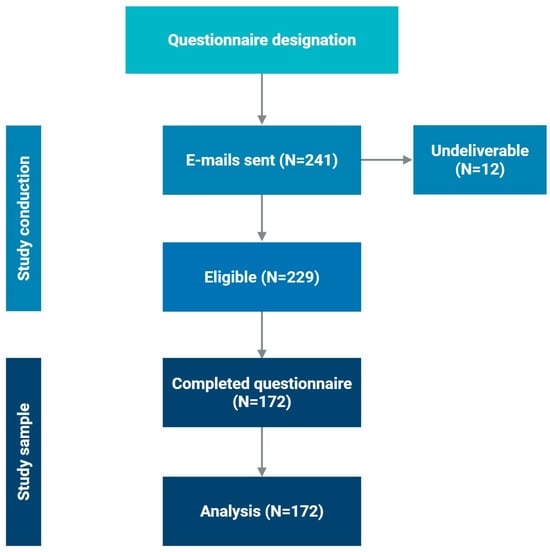
Figure 1
Open AccessCase Report
The Role of Stereolithographic Models in Preoperative Planning for Implant Rehabilitation in Patients with Severe Bone Atrophy
by
Alberto Gasbarri, Sofia Rastelli, Giulia Caporro, Giulia Ciciarelli, Mauro Arcangeli, Antonio Capogreco and Maurizio D'Amario
Oral 2025, 5(4), 92; https://doi.org/10.3390/oral5040092 - 18 Nov 2025
Abstract
►▼
Show Figures
Background and Objectives: Stereolithography (SLA) enables the creation of physical replicas of digital models, offering surgeons a realistic representation of patient anatomy. This technology improves diagnostics and surgical planning, facilitates communication within the medical team, and enhances the doctor–patient relationship by promoting compliance.
[...] Read more.
Background and Objectives: Stereolithography (SLA) enables the creation of physical replicas of digital models, offering surgeons a realistic representation of patient anatomy. This technology improves diagnostics and surgical planning, facilitates communication within the medical team, and enhances the doctor–patient relationship by promoting compliance. This study aims to place the intervention addressed in a broader context and highlight the utility of SLA models in complex surgical scenarios. Case Presentation: The study presents two cases of patients with severe maxillary atrophy: a 67-year-old healthy male (with well-controlled hypertension) and a 72-year-old female patient (with hypercholesterolemia). Intervention and Outcome: Zygomatic implant procedures with immediate loading were performed to resolve the bone atrophy in both cases. These procedures heavily leveraged preoperative planning using stereolithographic models. Both interventions resulted in a positive outcome, which was confirmed at the 6-month follow-up. Conclusions: The integration of stereolithographic models into the preoperative planning process improved the prognosis of these complex cases, confirming their value in managing severe maxillary atrophy.
Full article
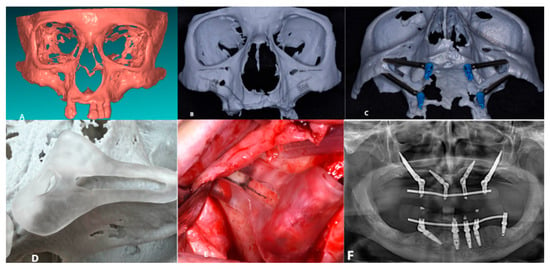
Figure 1
Open AccessArticle
Intraoral Pressure Differences Between Patients with Dysphagia and Healthy Individuals: A Pilot Study Using a Novel Intraoral Pressure Sensor
by
Saki Mizutani, Sachie Nakao, Rikako Sato, Akira Tada, Kota Amano, Mana Oshio, Atsuko Otsuka, Yoko Iwase and Hiroshige Taniguchi
Oral 2025, 5(4), 91; https://doi.org/10.3390/oral5040091 - 17 Nov 2025
Abstract
►▼
Show Figures
Background: Intraoral pressure contributes significantly to bolus transport during swallowing, along with tongue and pharyngeal pressures. However, conventional assessment methods (e.g., manometry, tongue pressure measurement) have limitations, including invasiveness, difficulty in capturing pressure gradients, and reliance on cognitive function. Objective: This study aimed
[...] Read more.
Background: Intraoral pressure contributes significantly to bolus transport during swallowing, along with tongue and pharyngeal pressures. However, conventional assessment methods (e.g., manometry, tongue pressure measurement) have limitations, including invasiveness, difficulty in capturing pressure gradients, and reliance on cognitive function. Objective: This study aimed to examine differences in intraoral pressure between patients with dysphagia and healthy controls using a newly developed, noninvasive intraoral pressure sensor. Methods: Sixteen individuals with dysphagia were categorized into two groups based on the Dysphagia Severity Scale (DSS): eight with mild dysphagia (DSS6-5) and eight with moderate dysphagia (DSS4-3). Seven healthy young adults (DSS7) were included as controls. Intraoral pressure was measured using a sensor enclosed in a silicone balloon placed in a standardized position. Three thickened liquids (mildly, moderately, and extremely thick) were tested, and intraoral pressure duration, peak pressure, and area were analyzed. Results: Pressure duration and area significantly increased with higher-viscosity samples in participants with dysphagia. Both parameters were significantly higher in the dysphagia groups than in controls (p < 0.001). For the extremely thick sample, pressure area was significantly greater in the mild dysphagia group than in controls (p = 0.031), and in the moderate group across all viscosities (p = 0.036; mildly thick, p = 0.010; moderately thick, p = 0.006; extremely thick, respectively). Conclusions: Intraoral pressure measurement may be a valuable supplementary screening tool, particularly for identifying moderate or more severe dysphagia.
Full article
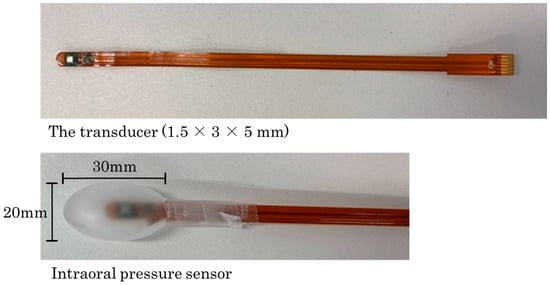
Figure 1
Open AccessSystematic Review
Artificial Intelligence Applications in Dentistry: A Systematic Review
by
Shareef Araidy, George Batshon and Roman Mirochnik
Oral 2025, 5(4), 90; https://doi.org/10.3390/oral5040090 - 7 Nov 2025
Abstract
Background: Artificial intelligence technologies are increasingly integrated into dental practice, offering potential improvements in diagnostic accuracy, treatment planning, and patient outcomes. However, the extent and quality of evidence supporting these applications remain unclear. Methodology: We conducted a systematic literature search using
[...] Read more.
Background: Artificial intelligence technologies are increasingly integrated into dental practice, offering potential improvements in diagnostic accuracy, treatment planning, and patient outcomes. However, the extent and quality of evidence supporting these applications remain unclear. Methodology: We conducted a systematic literature search using PubMed, Cochrane Library, Embase, and IEEE Xplore databases from January 2015 to December 2024. Search terms included combinations of “artificial intelligence,” “machine learning,” “deep learning,” “dentistry,” “diagnosis,” and “treatment planning.” Studies evaluating AI systems in clinical or laboratory settings with measurable outcomes were included. Data extraction followed PRISMA guidelines, and methodological quality was assessed using the QUADAS-2 tool. Results: Twenty-three studies met the inclusion criteria. Most focused on diagnostic accuracy (n = 21), with few addressing treatment planning (n = 1) or outcome prediction (n = 1). Reported accuracies ranged from 82–94% for caries detection, 85–92% for periodontal disease assessment, and 88–96% for oral lesion identification. Orthodontic applications achieved 95–98% accuracy in cephalometric landmark identification, while implant planning studies demonstrated up to 96% agreement with expert strategies. Despite promising technical performance, 79% of studies were retrospective and conducted in controlled research settings, with limited external or prospective clinical validation. Risk of bias was highest in patient selection due to frequent use of case–control designs and archived imaging datasets. Conclusions: AI shows significant promise for enhancing dental diagnostics and treatment planning. However, most applications require further clinical validation before routine implementation. The disconnect between laboratory performance and real-world clinical validation represents a critical gap that must be addressed. Current AI systems should be viewed as diagnostic aids rather than replacements for clinical judgment. Practitioners considering AI adoption should understand current limitations and evidence quality, particularly the lack of prospective clinical validation in diverse populations.
Full article
(This article belongs to the Special Issue Artificial Intelligence in Oral Medicine: Advancements and Challenges)
►▼
Show Figures

Figure 1
Open AccessArticle
In Vitro Testing of Botanical Extracts as Safe and Effective Alternatives for Oral Care: A Two-Pronged Model Integrating Pathogen Control and Host Compatibility
by
Nicole Beatrice Ponce, Nathalie B. Milbrandt, Md. Masud Alam, Carlene Rome M. Ledesma, Minseon Ju, Sylesh Venkataraman, Elena Draganoiu, Liliana Miinea, Yafan Li and Anna Cristina S. Samia
Oral 2025, 5(4), 89; https://doi.org/10.3390/oral5040089 - 6 Nov 2025
Abstract
►▼
Show Figures
Background: Commercial oral care products commonly incorporate synthetic antimicrobials such as cetylpyridinium chloride (Cetyl Cl.), L-Arginine (L-arg.), and stannous fluoride (SnF2). Although effective against oral pathogens, these agents are often associated with adverse effects including mucosal irritation, taste alteration, and disruption
[...] Read more.
Background: Commercial oral care products commonly incorporate synthetic antimicrobials such as cetylpyridinium chloride (Cetyl Cl.), L-Arginine (L-arg.), and stannous fluoride (SnF2). Although effective against oral pathogens, these agents are often associated with adverse effects including mucosal irritation, taste alteration, and disruption of the oral microbiome. These limitations have spurred growing interest in safer, plant-based alternatives. In this study, we present a two-pronged in vitro oral care testing model that integrates cell assays with machine-guided quantitative microscopy analyses to assess both antibacterial efficacy and host biocompatibility of botanical extracts. Methods: Using Miswak (Salvadora persica) and Neem (Azadirachta indica) as representative natural products, we conducted antibacterial and antibiofilm testing including the evaluation of the minimum inhibitory concentration (MIC), minimum biofilm inhibitory concentration (MBIC), and minimum biofilm eradication concentration (MBEC), alongside biocompatibility assessments via MTT cell viability assays on probiotic bacteria and mammalian oral cells. To evaluate biofilm structure and disruption, we employed scanning electron microscopy (SEM) and confocal laser scanning microscopy (CLSM), augmented with machine-guided Weka segmentation and automated image analysis. Results: Our findings show that Miswak and Neem extracts exhibited 75–100% antibacterial and antibiofilm efficacy against all tested bacteria, as demonstrated by cell assays and microscopy analyses, comparable to synthetic oral care agents. They also maintained ~100% viability toward commensal microbes and mammalian oral cells, whereas Cetyl Cl. and SnF2 showed dose-dependent cytotoxicity. Conclusions: This dual-assessment oral care testing model provides a comprehensive and biologically relevant framework for the discovery and screening of safe and effective natural herbal extracts in oral care applications.
Full article

Graphical abstract
Open AccessArticle
The Potential Effects of ACE Inhibitors on the Severity of Periodontal Disease-Related Attachment Loss: An Observational, Cross-Sectional Comparative Study
by
Kathrine Cullinan, Monika Behrens, Kylie Del Solar, Kimberley Johnson, Andrea James, Brian James and Alan Nimmo
Oral 2025, 5(4), 88; https://doi.org/10.3390/oral5040088 - 5 Nov 2025
Abstract
►▼
Show Figures
Background/Objectives: Angiotensin-converting enzyme (ACE) inhibitors are commonly prescribed anti-hypertensive agents. However, one of their effects is reducing the breakdown of a number of pro-inflammatory mediators, including bradykinin and substance P. Given the role of inflammation in periodontal disease, the aim of this study
[...] Read more.
Background/Objectives: Angiotensin-converting enzyme (ACE) inhibitors are commonly prescribed anti-hypertensive agents. However, one of their effects is reducing the breakdown of a number of pro-inflammatory mediators, including bradykinin and substance P. Given the role of inflammation in periodontal disease, the aim of this study was to see whether ACE inhibitors may have an influence on the severity of periodontal disease, as assessed by clinical attachment loss. Methods: A case–control retrospective study was undertaken through analysis of patient records from a specialist periodontic practice. Data regarding the loss of clinical attachment was collected from patients who were non-smokers and grouped according to patients prescribed ACE inhibitors, those taking other antihypertensive medication, and those taking no antihypertensive medication. Results: No statistically significant difference was observed between the three treatment groups in terms of mild to moderate loss of attachment (1–3 mm; 4–5 mm). However, a significantly higher incidence of severe attachment loss (>6 mm) was observed in patients prescribed ACE inhibitors, as compared to another antihypertensive or no antihypertensive medication. Conclusions: The incidence of severe loss of clinical attachment in this study was highest in those patients being prescribed ACE inhibitors. This effect would appear to be independent of the effects of the medication on blood pressure, since this was not observed with other antihypertensive medications, and hence may potentially relate to the known pro-inflammatory action of ACE inhibitors.
Full article
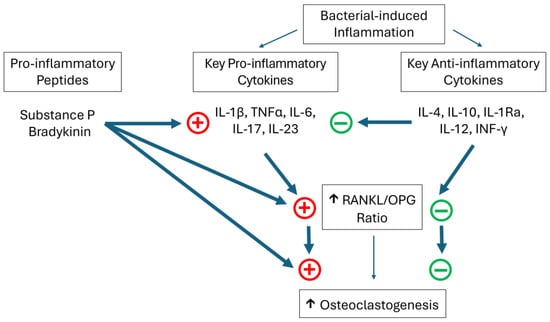
Figure 1
Open AccessArticle
Antimicrobial Activity of Oregano, Thyme, and Lavender Oils Against Oral Pathogens: Perspectives for AI-Supported Research
by
Casandra-Maria Radu, Carmen Corina Radu, Ionut-Daniel Venter, Mihaela Alexandra Bogdan and Dana Carmen Zaha
Oral 2025, 5(4), 87; https://doi.org/10.3390/oral5040087 - 4 Nov 2025
Abstract
►▼
Show Figures
Background: Antimicrobial resistance in oral pathogens drives interest in natural alternatives such as essential oils (EOs). Methods: The chemical composition and in vitro antimicrobial activity of Origanum vulgare, Thymus vulgaris, and Lavandula angustifolia EOs were investigated. Oils were profiled by gas
[...] Read more.
Background: Antimicrobial resistance in oral pathogens drives interest in natural alternatives such as essential oils (EOs). Methods: The chemical composition and in vitro antimicrobial activity of Origanum vulgare, Thymus vulgaris, and Lavandula angustifolia EOs were investigated. Oils were profiled by gas chromatography–mass spectrometry (GC-MS) and tested against Staphylococcus aureus ATCC 29213, Enterococcus faecalis ATCC 29212, Escherichia coli ATCC 25922, and Candida albicans ATCC 10231 using the disc diffusion method (triplicate, 1 µL/disc, ~850–950 µg). Results: O. vulgare oil produced the strongest inhibition against C. albicans (18.4 ± 0.5 mm), T. vulgaris was most active E. coli (13.0 ± 0.5 mm), while L. angustifolia showed negligible activity (6–7 mm). All EO inhibition zones were smaller than those of antibiotics. Conclusions: At clinically relevant doses, Oregano and Thyme oils showed modest antimicrobial effects, whereas Lavender was inactive. However, these findings are limited by the use of ATCC strains, small sample size, and reliance on the disc diffusion method, which provides only qualitative data and does not capture biofilm or host interactions. Future studies should include minimum inhibitory concentrations (MIC)/minimum bactericidal concentrations (MBC) assays, biofilm models, and cytotoxicity testing. AI-assisted GC-MS analysis and automated inhibition zone measurement should be considered as future perspectives to improve reproducibility and translational potential.
Full article
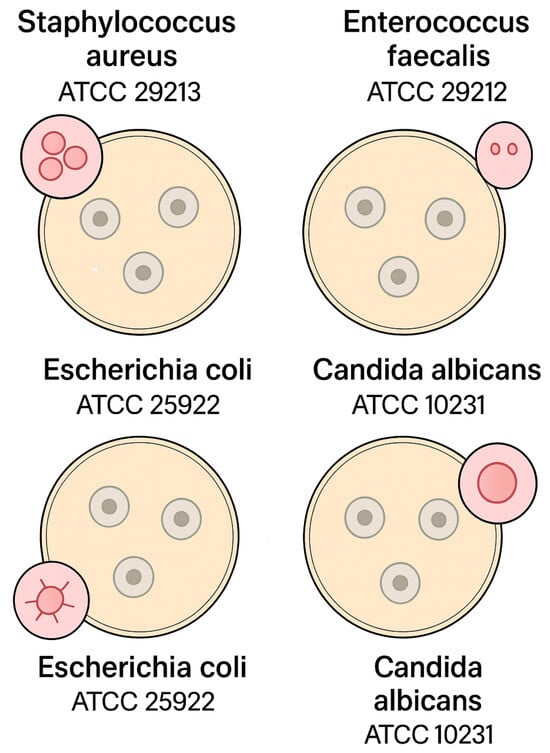
Figure 1
Open AccessArticle
Links Between Dental Anxiety and Preventive Dental Care: A Cross-Sectional Study in an Oral Surgery Practice
by
Rezart Qorri, Nertsa Cunoti, Laura Agnes Ingrid Magerfleisch, Erda Qorri, Katharina Marilena Weil, Juliane Häring, Hannah Tröger, Lisa Irmscher and Hendrik Berth
Oral 2025, 5(4), 86; https://doi.org/10.3390/oral5040086 - 3 Nov 2025
Abstract
Background/Objectives: Dental anxiety has been demonstrated to exert a significant influence on the frequency of treatment, the degree of patient compliance, and the long-term implications for oral health. The objective of this study was to evaluate the extent of dental anxiety experienced by
[...] Read more.
Background/Objectives: Dental anxiety has been demonstrated to exert a significant influence on the frequency of treatment, the degree of patient compliance, and the long-term implications for oral health. The objective of this study was to evaluate the extent of dental anxiety experienced by patients attending an oral surgery practice in Germany. In addition, the study sought to assess their preventive dental behaviour and to explore any potential associations between anxiety levels and the utilisation of preventive care services. Methods: The present study comprised 102 consecutive adult outpatients from a private oral surgery practice. The assessment of dental anxiety was conducted using the Corah’s Dental Anxiety Scale (DAS). The behaviour of the subjects in relation to preventative dental care was measured using a series of six standardised items, including the frequency of tooth brushing, tartar removal, and professional tooth cleaning. The data analysis comprised descriptive statistics, chi-square (χ2) tests, multiple linear regression, and one-way analysis of variance (ANOVA). Results: The mean DAS score was 12.69 (SD = 3.36). According to the DAS classification system, 28.4% of patients reported low anxiety, 50.0% moderate anxiety, and 21.6% high dental anxiety. Regression analysis explained 10% of the variance in DAS scores (R2 = 0.128, adj. R2 = 0.100). The analysis revealed that age (β = −0.218, p = 0.035) and lower educational level (β = −0.357, p < 0.001) were associated with higher anxiety scores, whereas sex was not a significant predictor. Preventive dental behaviour, encompassing practices such as tooth brushing, professional tooth cleaning, and tartar removal, did not exhibit significant disparities across anxiety groups (all p > 0.05). Conclusions: While dental anxiety was prevalent among the patient sample, it did not exert a significant influence on preventive dental behaviours. However, patients with lower levels of education and younger age exhibited higher dental anxiety scores. These findings underscore the necessity for targeted educational and preventive strategies in patients with elevated dental anxiety.
Full article
Open AccessReview
Effect of Adding Chitosan Nanoparticles to Acrylic Resin on Mechanical and Antimicrobial Properties of Removable Dentures: Scoping Review
by
Daniele Morais Dias, Letícia Pena Botelho, Larissa Doalla de Almeida e Silva, Maria Eliza da Consolação Soares and Rodrigo Galo
Oral 2025, 5(4), 85; https://doi.org/10.3390/oral5040085 - 3 Nov 2025
Abstract
►▼
Show Figures
Acrylic resin is widely used in removable dental prostheses due to its biocompatibility, low cost, and ease of handling; however, it presents mechanical limitations and a high susceptibility to microbial colonization, particularly by Candida albicans. The incorporation of nanoparticles into polymethyl methacrylate
[...] Read more.
Acrylic resin is widely used in removable dental prostheses due to its biocompatibility, low cost, and ease of handling; however, it presents mechanical limitations and a high susceptibility to microbial colonization, particularly by Candida albicans. The incorporation of nanoparticles into polymethyl methacrylate (PMMA) has been investigated as a strategy to mitigate these drawbacks. This scoping review evaluated the impacts of incorporating chitosan (CTS) nanoparticles into PMMA on antimicrobial activity and mechanical properties. A comprehensive search of the PubMed, Scopus, Web of Science, and BVS databases resulted in the retrieval of 1912 records. After removing 557 duplicates and applying the eligibility criteria, 9 in vitro studies were included. Despite methodological heterogeneity, most studies reported enhanced antifungal activity against C. albicans and improvements in mechanical properties, such as microhardness and overall strength, when CTS was incorporated. Thus, CTS appears to be a promising additive for denture base resins, with the potential to reduce denture-associated infections and increase the longevity of prostheses. Nevertheless, standardized methodologies and well-designed in vivo and clinical investigations remain essential to determine optimal concentrations, incorporation techniques, and long-term clinical performance before implementation. A scoping review design was selected due to the exploratory nature of the study and the heterogeneity of available evidence, which precludes direct comparisons and quantitative synthesis.
Full article

Figure 1
Open AccessReview
The Role of Digital Innovations in Shaping Contemporary Fixed Prosthodontics: A Narrative Review
by
Mariya Dimitrova
Oral 2025, 5(4), 84; https://doi.org/10.3390/oral5040084 - 20 Oct 2025
Abstract
The rapid digitization of dentistry is significantly transforming fixed prosthodontics, a discipline highly dependent on technical precision. This narrative review, incorporating a structured literature search, provides a critical overview of how digital tools—including computer-aided design and manufacturing (CAD/CAM), intraoral scanners (IOS), and additive
[...] Read more.
The rapid digitization of dentistry is significantly transforming fixed prosthodontics, a discipline highly dependent on technical precision. This narrative review, incorporating a structured literature search, provides a critical overview of how digital tools—including computer-aided design and manufacturing (CAD/CAM), intraoral scanners (IOS), and additive manufacturing—are influencing clinical protocols and production methods. A database-guided selection process was employed to identify relevant studies published between 2000 and 2024, spanning in vitro research, observational studies, and clinical trials. While digital workflows offer promising benefits, such as increased accuracy, efficiency, and patient comfort, supporting evidence remains preclinical or short-term in nature. The review highlights areas of innovation as well as ongoing limitations in clinical validation, standardization, and adoption. A more cautious interpretation of the current evidence is warranted, especially regarding long-term clinical outcomes and cost-effectiveness. This review aims to inform clinicians, researchers, and educators about both the potential and the present limitations of digital fixed prosthodontics.
Full article
(This article belongs to the Collection Digital Dentistry: State of the Art and Future Perspectives)
►▼
Show Figures

Figure 1
Open AccessArticle
Laser Doppler Flowmetry and Continuous Tissue Oxygenation Monitoring: Best of Vitality Tests?
by
Herman J. J. Roeykens, Rani D’haese, Wolfgang Jacquet, Roeland J. G. De Moor and Stefan Vandeweghe
Oral 2025, 5(4), 83; https://doi.org/10.3390/oral5040083 - 20 Oct 2025
Abstract
►▼
Show Figures
This study aimed to explore the added value and usage of laser Doppler flowmetry (LDF) in conjunction with continuous tissue (arterial) oxygen saturation (SO2) monitoring, electrical pulp testing (EPT), cold stimulation (CS) testing, and apical X-rays (RX). LDF data were evaluated
[...] Read more.
This study aimed to explore the added value and usage of laser Doppler flowmetry (LDF) in conjunction with continuous tissue (arterial) oxygen saturation (SO2) monitoring, electrical pulp testing (EPT), cold stimulation (CS) testing, and apical X-rays (RX). LDF data were evaluated in relation to three different scenarios. LDF records of all four upper incisors from 30 randomly selected patients aged 21–40 were analysed in relation to the following scenarios: (a) simultaneous SO2 measurements using a pre-manufactured splint handled by an experienced LDF dentist, (b) EPT, and (c) CS. A total of 120 teeth were analysed, of which 11 were non-vital (7 denervated and 4 traumatised). Data assessment showed the following mean LDF values: vital teeth: 23.6 Perfusion Units (PU), SD 6.3 and SaO2 of 88.7%, SD 17.1. For non-vital teeth, the mean LDF value was 16.1 PU (SD 11.8) and the mean SO2 value was 70.8% (SD 31.9). The standard deviation was found to be twice as high for non-vital teeth as for vital teeth. No direct relationship was found between LDF and SO2 values at low SO2. For vitality discrimination, the ROC curves showed an area under the curve of 0.799 for LDF and 0.643 for SO2. EPT data assessment showed a mean value of 18.1 (SD 19.7) out of a possible score of 0–80. This was distributed as follows: seven non-vital teeth (80/80); 109 vital teeth; and four undecided teeth. This was compared to the LDF and SO2 results. The data assessment showed nine non-vital teeth, 108 vital teeth, and three undecided teeth in comparison to LDF and SO2 results. Conclusion: LDF and SO2 do not complement each other sufficiently in detecting non-vital teeth when the selection criteria are applied. While LDF clearly contributes, the vital or non-vital classification still depends on a combination of X-ray, sensitivity, and vitality tests.
Full article

Graphical abstract
Highly Accessed Articles
Latest Books
E-Mail Alert
News
Topics
Topic in
JFB, Materials, Prosthesis, IJMS, Oral, JCM
New Technological and Clinical Advances for Controlling Peri-Implantitis
Topic Editors: Javier Gil, Eugenio Velasco-Ortega, Aritza Brizuela-Velasco, Conrado AparicioDeadline: 31 March 2026
Topic in
Healthcare, JCM, JPM, Oral
Advances in Dental Health, 2nd Edition
Topic Editors: Sabina Saccomanno, Gianni GallusiDeadline: 25 July 2026
Topic in
Biomedicines, Cancers, Diagnostics, JCM, Oral
Sustainable Point-of-Care Diagnostics for Early Oral Cancer Detection
Topic Editors: Muy-Teck Teh, Dipak Sapkota, Tami YapDeadline: 30 August 2026

Special Issues
Special Issue in
Oral
Artificial Intelligence in Oral Medicine: Advancements and Challenges
Guest Editor: Xiaoyuan HanDeadline: 20 December 2025
Special Issue in
Oral
Advanced Radiographic Techniques in Endodontics
Guest Editor: Jörg Philipp TchorzDeadline: 10 February 2026
Special Issue in
Oral
Assessment: Strategies for Oral Health Education
Guest Editor: Adam S. HasanDeadline: 20 March 2026
Special Issue in
Oral
Temporomandibular Disorders and Oral Rehabilitation
Guest Editor: Annalisa MonacoDeadline: 20 April 2026
Topical Collections
Topical Collection in
Oral
Oral and Systemic Health: Border Dentistry and the Borders of Dental Practice
Collection Editors: Giuseppina Campisi, Marco Mascitti
Topical Collection in
Oral
Medication-Related Osteonecrosis of the Jaw (MRONJ): Current Practice, New Tools and Future Trends
Collection Editors: Giacomo Oteri, Umberto Romeo, Rodolfo Mauceri, Alberto Bedogni, Vittorio Fusco
Topical Collection in
Oral
Synthesis, Testing and Mechanical Behavior of Dental Biomaterials at Different Clinical Parameters
Collection Editors: Joao Paulo Tribst, Eugenio Pedullà
Topical Collection in
Oral
Digital Dentistry: State of the Art and Future Perspectives
Collection Editors: Lucio Lo Russo, Ji-Man Park










